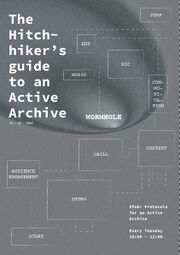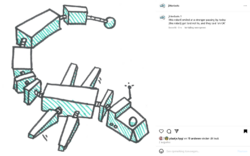User:Thijshijsijsjss/PTMoMNBM/Human Parser: Difference between revisions
m (Fix indentation) |
m (Change list type) |
||
| Line 343: | Line 343: | ||
I keep track of a steadily growing body of directly or tangentially related references [[User:Thijshijsijsjss/Gossamery|in my reader]]. Some key references that have informed this proposal are included below. | I keep track of a steadily growing body of directly or tangentially related references [[User:Thijshijsijsjss/Gossamery|in my reader]]. Some key references that have informed this proposal are included below. | ||
<div class="mw-collapsible-content"> | <div class="mw-collapsible-content"> | ||
*Aarseth, E.J. (2003) 'Nonlinearity and Literary Theory', in Wardin-Fruin, N. and Montfort, N. (eds.) The New Media Reader. Cambridge, Massachusetts, United States of America and London, England: The MIT Press, 761-780. | |||
*Magnuson, J. and Games Now! ''Videogames Are Poems | Games Now!''. Available at https://www.youtube.com/watch?v=C1UepnhRFOk (Accessed: 30 July 2024). | |||
*Aron, E.A. (2016) ''The Highly Sensitive Person''. 54th edn. New York, United States of America: Harmony Books. | |||
</div></div> | </div></div> | ||
</div> | </div> | ||
Revision as of 22:17, 23 October 2024
Disclaimer: despite being lengthier, more detailed and perhaps even more ambitious in scope and captured interests, this is still a Project that May or may not be made. Don't forget that, Thijs!
A parser is an interpreting agent -- what is a 'human parser?'
A human parser is an interpreter that happens to be a human agent
A human parser is an interpreter that parses humans
A human parser makes the act of parsing, or interpreting, human
Draft 1
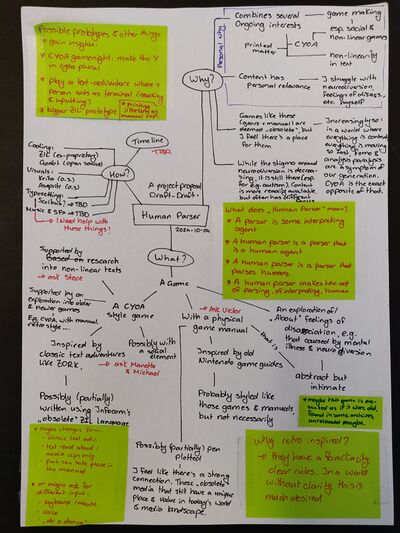
What do you want to make? Human Parser is a project around a Choose Your Own Adventure (CYOA) style game that is an exporation of the disassociative feelings caused by mental illness and neurodiversion. This exploration is abstract yet intimate, stemming from personal experiences of myself and others.
The gameplay content is yet to be determined, but is inspired by old text adventure and retro games. It will likely contain 2D 'pixel art' visuals. The starting point for the game is digital, but based on testing during development, elements or everything might turn physical or immaterial.
The game is accompanied by a physical game manual, providing insights into the game and adding more thematic cohesion. It might contain visuals taken and / or re-imagined from the game, guides for gameplay, behind the scenes info, but also a broader exploration of the theme through e.g. interview snippets.
Why do you want to make it? Text adventure and CYOA games are often seen as relics of the past, "obsolete" genres, but I feel like there is still a place for them. In fact, increasingly so: in the current world, everything is content, everything is moving fast, and every moment is a moment of decision. Amidst this constant overwhelming exposure, "FOMO" and analysis paralysis are symptoms characterising a generation. CYOA fundamentally opposes the idea of mass content, of experiencing it all.
One group of people who tend to struggle more in this landscape are neurodivergent people (citation needed). While the stigma surrounding this topic is slowly decreasing, it still persist. Especially in big media, representation is sparse and, if present at all, heavily stereotyped. There is room for more authentic experiences and representations. By their interactive and explorative nature, games could be a good carrier for such a conversation.
I myself feel the need for this conversation. Mental illness and neurodiversion have defined important parts of my life so far, and I often struggle with feelings of disassociation. I have started to explore these themes in previous projects, and feel like these have been just the tip of the iceberg. This project would allow me to continue the exploration of not just this theme, but also of several media of interest: gamemaking (and CYOA), printmaking (possibly involving pen plotters or web-to-print).
Moreover, I feel like a game manual -- similar in its status as 'obsolete' -- fits this project well. Firstly, thematically: neurodivergent people are often told to come with 'their manual'. What is a manual anyway, when it comes to people? Also, it fits mechanically: in the contemporary landscape of interwoven media, I see potential for it to breath new life in the CYOA genre, extending decision making beyond the digital realm and blurring the thematic and gameplay content.
I have the hopes for this project to be both an relatable experience to those struggling with disassociation themselves, and an interesting game in its own right to be enjoyed by any lover of classic videogames. This second point is important to me: the game should not just be academically interesting, but an actual worthwhile playable experience.
How do you plan to make it? Realising this project will require two interwoven phases: research and creation. Presented below is a list of methods, according to each phase. The methods listed are merely starting points. While working on this project, I expect many more questions of 'how' to pop up. I will embrace this.
Aside from these two phases, there's a writing phase that will continue throughout, and is for now not bound to specific methods, but will be listed as past of creation in the timetable that will follow.
The 'how' of research involves:
|
The 'how' of creation involves:
|
What is your timetable?
| Research phase | Creation phase | |
| October | Gathering references through reading material broadly related
Playing classic and contemporary CYOA and retro (style) games Compile references including texts and games and manuals |
Re-familiarizing myself with Godot
Making prototypes to play with others, in particular to test at the first public moment Compile visual styleguide |
| November | Continue to do research, but moving towards more specific references
Create list of core reference texts and projects Start digestive writing on these references |
Decide on a format to use and create skeleton framework in this format
Refine proposal based on prototyping decisions and findings |
| November 4th: first public moment | ||
| November 22nd: proposal deadline | ||
| December 13th: first chapter deadline | ||
| December | Reach out to possible interviewees and testers
Revisit proposal and adjust according to newfound results |
Create thesis skeleton structure and write first chapter
Have tests ready Start to extent tests towards final game |
| January | Conduct tests and interviews | Continue writing, game making
Create manual skeleton Refine timeline for second half of the project |
| February | Continue writing and making ... | |
| February 14th: first draft thesis deadline | ||
| March | Continue writing and making ... | |
| March 14th: second draft thesis deadline | ||
| April | Continue writing and making ... | |
| April 18th: thesis deadline | ||
Who can help you? Similarly to 'how', this list will surely be appended to throughout working on the project. The list below is just a starting point.
- Steve Rushton: references for non-linear (and experimental) writing
- Michael Murtaugh: references for text adventures and CYOA
- Manetta Berends: references for text adventures and CYOA
- Lídia Pereira: references for people and project in the contemporary scenes adjacent to CYOA
- Marloes de Valk: ask about What Remains -- another retro inspired game with the aim to contribute to a modern day conversation
- Victor Utne Stiberg: assistence with printmaking tests and general design guidance
- Wang Ziheng: discuss music and SFX in retro videogames
- "interviewees" or otherwise people to talk to about neurodiversion etc
- testers (probably I will call upon my network of game design students from the UU and HKU)
- classmates and friends to discuss, share, motivate and ground myself
Relation to previous practise
I have several years of game making experience: practical, theoretical (GMT master program), and social (participating in jams and creating for events such as gameforce). In the past year, I have made multiple endeavors in (stretching) the CYOA format (in particular the THGTAAA radio show, the Archival Oceans zine, Wiki Wanderer and my T2 assessment).
I have made explorations of a similar theme as well. In particular, Jitterbots.
Finally, in the past year I have started to develop a printmaking practise through various zine (e.g. Archival Oceans), handouts (e.g. SI23's) and plenty of pen plotting (e.g. album covers). Also, more recently I was part of the second coming of the Counter-Tourist Information Center, for which we produced a daily micro-newspaper. While I don't intent to repeat this method of rapid production here, it was a great experience both in terms of gathering material, working with new software and collaborative publication.
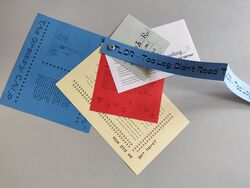
|

|
Relation to a larger context
References / bibliography
Draft 2
What do you want to make? Human Parser is a project around a text-adventure game that is an exporation of feelings of disassociativity, particularly those caused by mental illness and neurodiversion. This exploration is abstract yet intimate, stemming from personal experiences of myself and others. Using text-adventure gameplay, a player uses text input to play. While informed by classic games of the genre, Human Parser does not limit itself to text: it makes use of pixel art visuals and gaming conventions of contemporary and experimental games. The game is about assembling and embodying robots. Following a loose story, a playthrough consists of 2 parts: robot creation at the Robot Assembly Line, and playing as the created robot in the Performance Testing Facility. One playthrough should take 10-15 minutes. By the end, user inputs are chained together to form a poem that is shown when one of a handful of endings is reached. (Game content may change over the course of research and development) The game is accompanied by a physical game manual, providing insights into the game and adding more thematic cohesion. It might contain visuals taken and / or re-imagined from the game, guides for gameplay, (fictionalized) behind the scenes information, poems created by playing, but also a broader exploration of the theme through e.g. interview snippets. Finally, for exhibition at e.g. a graduation show, I could see this project being playable and hooked up to a pen plotter. After a playthrough, the generated poem is automatically send to the plotter, and a book is kept of all poems generated this way. This can hopefully allow for the conversation on disassociativity to continue beyond the digital, individual realm.
Why do you want to make it? Text adventure and Choose Your Own Adventure (CYOA) games are "obsolete" genres, often seen as relics of the past, but I feel like there is still a place for them. In fact, increasingly so: in the current media landscape, everything is content, everything is moving fast, and every moment is a moment of decision. Amidst this constant overwhelming exposure, "FOMO" and analysis paralysis are symptoms characterising a generation. CYOA fundamentally opposes the idea of mass content, of experiencing it all. This media landscape is a big contributing factor in experiencing 'disassociation' that I myself often struggle with. In turn, disassociation is both a catalyst to and catalyzed by mental illness and neurodiversion. While the stigma surrounding this topic is slowly decreasing, it still persist. representation is sparse and, if present at all, heaviliy stereotyped. I would like to see a more free-form, abstract and authentic display of the experience of disassociation. By their interactive and explorative nature, I feel like a game can be a good carrier for that. I have started to explore these themes in previous projects, and feel like these have been just the tip of the iceberg. This project would allow me to continue the exploration of not just this theme, but also of several media of interest: gamemaking (and text-adventures), printmaking (possibly involving pen plotters), writing (experimentally) and storytelling (intimately). Moreover, I feel like a game manual -- similar in its status as 'obsolete' -- fits this project well. Firstly, thematically: neurodivergent people are often told to come with 'their manual'. What is a manual anyway, when it comes to people? Also, it fits mechanically: in the contemporary landscape of interwoven media, I see potential for it to breath new life in the CYOA genre, extending decision making beyond the digital realm and blurring the thematic and gameplay content. I have the hopes for this project to be both an relatable experience to those struggling with disassociation themselves, and an interesting game in its own right to be enjoyed by any lover of classic videogames. This second point is important to me: the game should not just be academically interesting, but an actual worthwhile playable experience.
How do you plan to make it? Realising this project will require two interwoven phases: research and creation. Presented below is a list of methods, according to each phase. The methods listed are merely starting points. While working on this project, I expect many more questions of 'how' to pop up. I will embrace this. Aside from these two phases, there's a writing phase that will continue throughout, and is for now not bound to specific methods, but will be listed as past of creation in the timetable that will follow.
The 'how' of research involves:
|
The 'how' of creation involves:
|
What is your timetable?
| Research phase | Creation phase | |
| October | Gathering references through reading material broadly related
Playing classic and contemporary CYOA and retro games Compile references including texts and games and manuals |
Re-familiarizing myself with Godot
Making prototypes to play with others, in particular to test at the first public moment Compile visual styleguide |
| November | Continue to do research, move to specific references
Create list of core reference texts and projects Start digestive writing on these references |
Decide on a format to use and create skeleton framework in this format
Refine proposal based on prototyping decisions and findings Refine game ideas |
| November 4th: first public moment | ||
| November 22nd: proposal deadline | ||
| December | Reach out to possible interviewees and testers
Revisit proposal and adjust according to newfound results Refine timeline for second half of the project |
Create thesis skeleton structure and write first chapter
Have tests ready Start to extent tests towards final game |
| December 13th: first chapter deadline | ||
| January | Conduct tests and interviews | Continue writing, game making
Create manual skeleton
|
| February | Continue writing and making ... | |
| February 14th: first draft thesis deadline | ||
| March | Continue writing and making ... | |
| March 14th: second draft thesis deadline | ||
| April | Continue writing and making ... | |
| April 18th: thesis deadline | ||
Who can help you? Similarly to 'how', this list will surely be appended to throughout working on the project. The list below is just a starting point. *Steve Rushton: references for non-linear (and experimental) writing *Michael Murtaugh: references for text adventures and CYOA and general brainstorming and feedback *Manetta Berends: prototyping brainstorming and feedback *Joseph Knierzinger: prototyping brainstorming and feedback *Lídia Pereira: references for people and project in the contemporary scenes adjacent to CYOA *Marloes de Valk: ask about What Remains -- another retro inspired game with the aim to contribute to a modern day conversation *Victor Utne Stiberg: assistence with printmaking tests and general design guidance *Wang Ziheng: discuss music and SFX in retro videogames *Interviewees or otherwise people to talk to about games, neurodiversion, etc. *Testers (probably I will call upon my network of game design students from the UU and HKU) *Classmates and friends to discuss, share, motivate and ground myself
Relation to previous practise I have several years of game making experience: practical, theoretical (GMT master program), and social (participating in jams and creating for events such as gameforce). In the past year, I have made multiple endeavors in (stretching) the CYOA format (in particular the THGTAAA radio show, the Archival Oceans zine, Wiki Wanderer and my T2 assessment). Additionally, I made a bite-sized text adventure with Senka: Electrifying
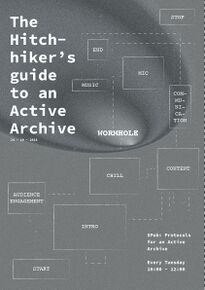
|
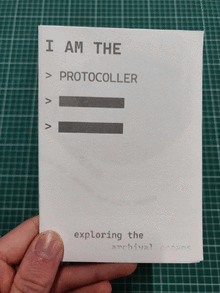
|
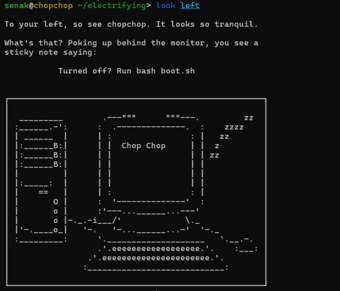
|
I have made explorations of a similar theme as well. In particular, Jitterbots: an exploration of disassociativity through a poem-comic.
Finally, in the past year I have started to develop a printmaking practise through various zine (e.g. Archival Oceans), handouts (e.g. SI23's) and plenty of pen plotting (e.g. album covers). Also, more recently I was part of the second coming of the Counter-Tourist Information Center, for which we produced a daily micro-newspaper. While I don't intent to repeat this method of rapid production here, it was a great experience both in terms of gathering material, working with new software and collaborative publication.

|

|
Relation to a larger context todo
References / Bibliography I keep track of a steadily growing body of directly or tangentially related references in my reader. Some key references that have informed this proposal are included below.
- Aarseth, E.J. (2003) 'Nonlinearity and Literary Theory', in Wardin-Fruin, N. and Montfort, N. (eds.) The New Media Reader. Cambridge, Massachusetts, United States of America and London, England: The MIT Press, 761-780.
- Magnuson, J. and Games Now! Videogames Are Poems | Games Now!. Available at https://www.youtube.com/watch?v=C1UepnhRFOk (Accessed: 30 July 2024).
- Aron, E.A. (2016) The Highly Sensitive Person. 54th edn. New York, United States of America: Harmony Books.

